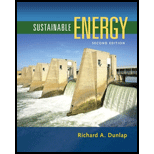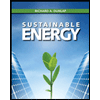
Sustainable Energy
2nd Edition
ISBN: 9781337551663
Author: DUNLAP, Richard A.
Publisher: Cengage,
expand_more
expand_more
format_list_bulleted
Concept explainers
Question
Chapter 3, Problem 17P
(a)
To determine
Calculate the cost of energy from gasoline and from electricity from the public utility and compare it.
(b)
To determine
Calculate the transportation costs for gasoline and electric vehicles.
Expert Solution & Answer
Want to see the full answer?
Check out a sample textbook solution
Students have asked these similar questions
8.4 Consider a Poisson regression model for the
number of social/recreational trips generated during
a peak-hour period that is estimated by (see Eq. 8.3)
BZ = -0.75 +0.025(household size) + 0.008(annual
household income, in thousands of dollars) +
0.10(number of nonworking household members).
Suppose a household has five members (three of
whom work) and an annual income of $100,000.
What is the expected number of peak-hour
social/recreational trips, and what is the probability
that the household will not make a peak-hour
social/recreational trip?
8.15 An origin-destination pair is connected by a
route with a performance function t₁ = 8+ x1, and
another with a function t₂ = 1 + 2x2 (with x's in
thousands of vehicles per hour and t's in minutes). If
the total origin-destination flow is 4000 veh/h,
determine user-equilibrium and system-optimal route
travel times, total travel time (in vehicle minutes),
and route flows.
8.13 Consider the situation described in Problem
8.11. If the total number of trips remains constant,
determine the amount of amusement floor space that
must be added to destination 2 to attract an
additional 50 social/recreational trips.
Knowledge Booster
Learn more about
Need a deep-dive on the concept behind this application? Look no further. Learn more about this topic, civil-engineering and related others by exploring similar questions and additional content below.Similar questions
- 5- A basic freeway has 3 lanes in each direction and is on flat terrain. It has a jam density of 190 veh/km and a capacity of 4750 veh/h. The spot speed of 5 cars was collected at the midpoint of a 3.4 km segment of this freeway. Vehicle Speed (km/hr) 1 86 2 89 3 95 4 5 99 100 a) Calculate the space mean speed b) Calculate the free flow speed based on the given information c) A directional weekday peak-hour volume of 4640 vehicles is observed, with 1320 vehicles arriving in the most congested 15-min period. If the traffic stream has 12% large trucks and buses determine the level of service 6- What are the steps that a 4-step model used to predict travel demand on roads network consists of? Briefly describe was sort of information each step provides? 7- The bitumen is a conventional bituminous binder has a penetration index of -1 and = 65°c. T800 pen a) Determine the stiffness modulus of this bitumen if the operating conditions are as follows: temperature of 25°c and loading time of…arrow_forwardQ) Find the location of centroid for the shaded area shown in Figure below. 20mm 42mm 23mm 30mm 30mm 10mm Xarrow_forwardQuestion 5 (Force Method). Determine the reaction at the supports. Assume A is fixed and B and C are rollers. El is constant. 3 k/ft A 10 ft B 2 k/ft 10 ft Carrow_forward
- Find the collapse load (Wu) for the one-end continuous beam shown below. Wu 6 marrow_forward4- As part of a highway interchange project, a ramp will be constructed to allow the vehicles exit the first highway and enter the second highway. The first highway runs north-south and the second one had a right angle to the first one (it runs east-west). Vehicles going to the north can use this exit ramp to enter the second highway as shown in the plan view in the figure below. The design speed in both highways is 100 km/hr. The stationing of the start of the horizontal curve is 40+00. a) Determine the stationing of PI and PT¶ b) The first highway has a vertical grade of +3.5% and the second highway has a grade of - 0.5%. The stationing of the beginning and the end of the crest curve are the same as the horizontal curve. What is the elevation of the end of the vertical curve (PVT) if the elevation of the start point (PVC) is 1500m c) Calculate K for the vertical curve Plan view (horizontal alignment) PT 1 N Profile view (vertical alignment) G1=0.5% PVT PC, 40+00 PVC G1=+3.5%arrow_forward10- A pavement with a thin bituminous surface is going to be constructed with a design traffic of 6*105 ESA. Laboratory testing of the subgrade and pavement materials has given the following CBR values. Design the pavement using the empirical design method. Use the and show how you got the numbers on the graph relevant graph} Subgrade CBR: 5 Granular subbase material: Upper layer CBR> 30 Lower layer CBR = 10 Granular base material CBR >100arrow_forward
- 1- Describe the perception-reaction process in driver's decision making. What are the steps this process consists of and what tasks are included in each step? Why this process should be considered in transportation planning 3- What are the three main parts that can be included in a road cross section? Briefly describe what each part is for? Sketch a typical cross sectionarrow_forwardNote: Please provide a clear, step-by-step simplified handwritten working out (no explanations!), ensuring it is done without any AI involvement. I require an expert-level answer, and I will assess and rate based on the quality and accuracy of your work and refer to the provided image for more clarity. Make sure to double-check everything for correctness before submitting appreciate your time and effort!.arrow_forward8- A granular pavement with thin bituminous surfacing is going to be constructed in a rural area and it is estimated that the average annual daily traffic will be 21,000 vehicles per day. The road will have 3 lanes in each direction. The survey data from the existing roads close to that area shows that 15% of the vehicles in the traffic stream are heavy and the rest are light. However, no details of heavy vehicle types are given. It is also estimated that the annual growth factor is 3.2%. Determine the design traffic (DESA) assuming that the damage index (ESA/HVAG) is 0.9 9- a) What are the three main distress modes in flexible pavements (3 points)? b) What are their likely causesarrow_forward
arrow_back_ios
SEE MORE QUESTIONS
arrow_forward_ios
Recommended textbooks for you

 Engineering Fundamentals: An Introduction to Engi...Civil EngineeringISBN:9781305084766Author:Saeed MoaveniPublisher:Cengage Learning
Engineering Fundamentals: An Introduction to Engi...Civil EngineeringISBN:9781305084766Author:Saeed MoaveniPublisher:Cengage Learning Solid Waste EngineeringCivil EngineeringISBN:9781305635203Author:Worrell, William A.Publisher:Cengage Learning,
Solid Waste EngineeringCivil EngineeringISBN:9781305635203Author:Worrell, William A.Publisher:Cengage Learning, Sustainable EnergyCivil EngineeringISBN:9781133108689Author:Richard A. DunlapPublisher:Cengage Learning
Sustainable EnergyCivil EngineeringISBN:9781133108689Author:Richard A. DunlapPublisher:Cengage Learning


Engineering Fundamentals: An Introduction to Engi...
Civil Engineering
ISBN:9781305084766
Author:Saeed Moaveni
Publisher:Cengage Learning

Solid Waste Engineering
Civil Engineering
ISBN:9781305635203
Author:Worrell, William A.
Publisher:Cengage Learning,

Sustainable Energy
Civil Engineering
ISBN:9781133108689
Author:Richard A. Dunlap
Publisher:Cengage Learning